9-simplex
In geometry, a 9-simplex is a self-dual regular 9-polytope. It has 10 vertices, 45 edges, 120 triangle faces, 210 tetrahedral cells, 252 5-cell 4-faces, 210 5-simplex 5-faces, 120 6-simplex 6-faces, 45 7-simplex 7-faces, and 10 8-simplex 8-faces. Its dihedral angle is cos−1(1/9), or approximately 83.62°.
| Regular decayotton (9-simplex) | |
|---|---|
 Orthogonal projection inside Petrie polygon | |
| Type | Regular 9-polytope |
| Family | simplex |
| Schläfli symbol | {3,3,3,3,3,3,3,3} |
| Coxeter-Dynkin diagram | |
| 8-faces | 10 8-simplex |
| 7-faces | 45 7-simplex |
| 6-faces | 120 6-simplex |
| 5-faces | 210 5-simplex |
| 4-faces | 252 5-cell |
| Cells | 210 tetrahedron |
| Faces | 120 triangle |
| Edges | 45 |
| Vertices | 10 |
| Vertex figure | 8-simplex |
| Petrie polygon | decagon |
| Coxeter group | A9 [3,3,3,3,3,3,3,3] |
| Dual | Self-dual |
| Properties | convex |
It can also be called a decayotton, or deca-9-tope, as a 10-facetted polytope in 9-dimensions.. The name decayotton is derived from deca for ten facets in Greek and yotta (a variation of "oct" for eight), having 8-dimensional facets, and -on.
Coordinates
The Cartesian coordinates of the vertices of an origin-centered regular decayotton having edge length 2 are:
More simply, the vertices of the 9-simplex can be positioned in 10-space as permutations of (0,0,0,0,0,0,0,0,0,1). This construction is based on facets of the 10-orthoplex.
Images
| Ak Coxeter plane | A9 | A8 | A7 | A6 |
|---|---|---|---|---|
| Graph |  |
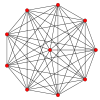 |
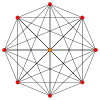 |
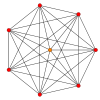 |
| Dihedral symmetry | [10] | [9] | [8] | [7] |
| Ak Coxeter plane | A5 | A4 | A3 | A2 |
| Graph | 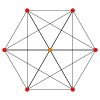 |
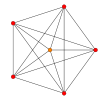 |
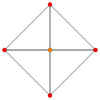 |
 |
| Dihedral symmetry | [6] | [5] | [4] | [3] |
References
- Coxeter, H.S.M.:
- — (1973). "Table I (iii): Regular Polytopes, three regular polytopes in n-dimensions (n≥5)". Regular Polytopes (3rd ed.). Dover. p. 296. ISBN 0-486-61480-8.
- Sherk, F. Arthur; McMullen, Peter; Thompson, Anthony C.; Weiss, Asia Ivic, eds. (1995). Kaleidoscopes: Selected Writings of H.S.M. Coxeter. Wiley. ISBN 978-0-471-01003-6.
- (Paper 22) — (1940). "Regular and Semi Regular Polytopes I". Math. Zeit. 46: 380–407. doi:10.1007/BF01181449.
- (Paper 23) — (1985). "Regular and Semi-Regular Polytopes II". Math. Zeit. 188: 559–591. doi:10.1007/BF01161657.
- (Paper 24) — (1988). "Regular and Semi-Regular Polytopes III". Math. Zeit. 200: 3–45. doi:10.1007/BF01161745.
- Conway, John H.; Burgiel, Heidi; Goodman-Strass, Chaim (2008). "26. Hemicubes: 1n1". The Symmetries of Things. p. 409. ISBN 978-1-56881-220-5.
- Johnson, Norman (1991). "Uniform Polytopes" (Manuscript). Cite journal requires
|journal=(help)- Johnson, N.W. (1966). The Theory of Uniform Polytopes and Honeycombs (PhD). University of Toronto. OCLC 258527038.
- Klitzing, Richard. "9D uniform polytopes (polyyotta) x3o3o3o3o3o3o3o3o — day".
External links
- Glossary for hyperspace, George Olshevsky.
- Polytopes of Various Dimensions
- Multi-dimensional Glossary
Fundamental convex regular and uniform polytopes in dimensions 2–10 | ||||||||||||
|---|---|---|---|---|---|---|---|---|---|---|---|---|
| Family | An | Bn | I2(p) / Dn | E6 / E7 / E8 / F4 / G2 | Hn | |||||||
| Regular polygon | Triangle | Square | p-gon | Hexagon | Pentagon | |||||||
| Uniform polyhedron | Tetrahedron | Octahedron • Cube | Demicube | Dodecahedron • Icosahedron | ||||||||
| Uniform 4-polytope | 5-cell | 16-cell • Tesseract | Demitesseract | 24-cell | 120-cell • 600-cell | |||||||
| Uniform 5-polytope | 5-simplex | 5-orthoplex • 5-cube | 5-demicube | |||||||||
| Uniform 6-polytope | 6-simplex | 6-orthoplex • 6-cube | 6-demicube | 122 • 221 | ||||||||
| Uniform 7-polytope | 7-simplex | 7-orthoplex • 7-cube | 7-demicube | 132 • 231 • 321 | ||||||||
| Uniform 8-polytope | 8-simplex | 8-orthoplex • 8-cube | 8-demicube | 142 • 241 • 421 | ||||||||
| Uniform 9-polytope | 9-simplex | 9-orthoplex • 9-cube | 9-demicube | |||||||||
| Uniform 10-polytope | 10-simplex | 10-orthoplex • 10-cube | 10-demicube | |||||||||
| Uniform n-polytope | n-simplex | n-orthoplex • n-cube | n-demicube | 1k2 • 2k1 • k21 | n-pentagonal polytope | |||||||
| Topics: Polytope families • Regular polytope • List of regular polytopes and compounds | ||||||||||||